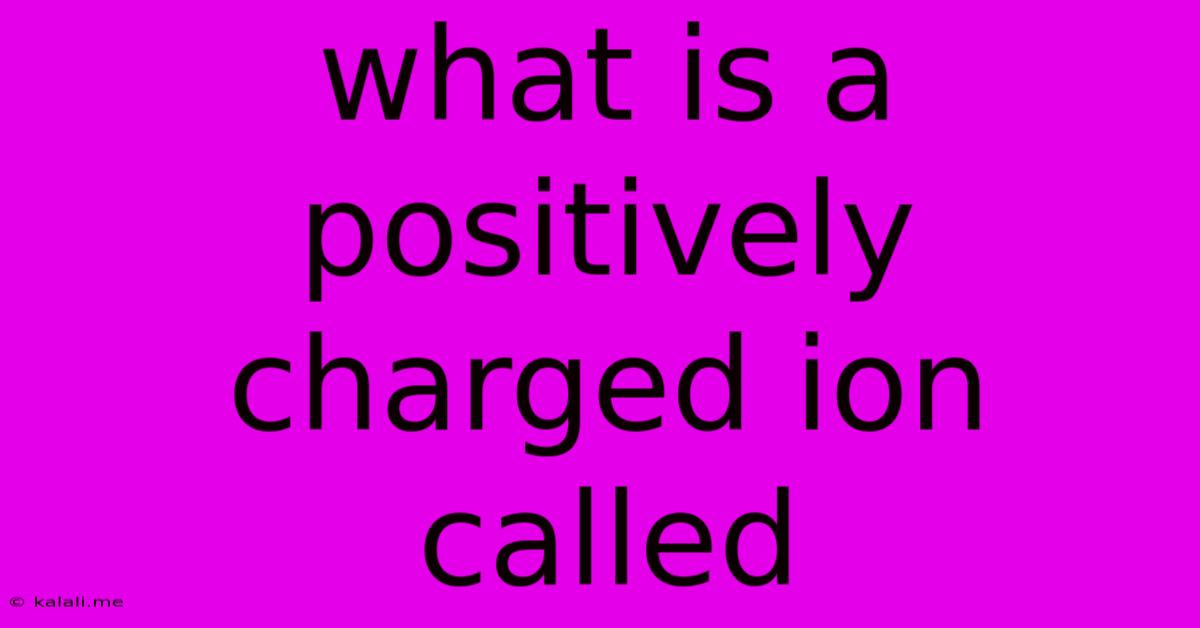What Is A Positively Charged Ion Called
Kalali
Jun 12, 2025 · 3 min read

Table of Contents
What is a Positively Charged Ion Called? A Deep Dive into Cations
Have you ever wondered what happens when an atom loses an electron? The answer lies in the fascinating world of ions, and specifically, cations. This article will explore what a positively charged ion is, how it's formed, and its importance in various fields.
What is an Ion?
Before we dive into positively charged ions, let's establish a basic understanding of ions themselves. An ion is an atom or molecule that has gained or lost one or more electrons, resulting in a net electrical charge. This charge imbalance is what distinguishes ions from neutral atoms or molecules. Ions can be either positively charged or negatively charged, depending on whether they've lost or gained electrons.
Understanding Cations: The Positively Charged Ions
A cation is simply an atom or molecule that carries a positive charge. This positive charge arises because the atom or molecule has lost one or more electrons. The loss of negatively charged electrons leaves behind a surplus of positive charge from the protons in the nucleus. The number of positive charges a cation possesses equals the number of electrons lost. For example, a sodium ion (Na⁺) has lost one electron, giving it a +1 charge, while a calcium ion (Ca²⁺) has lost two electrons, resulting in a +2 charge.
How are Cations Formed?
Cations typically form when an atom with relatively loosely held electrons interacts with an atom that has a strong affinity for electrons. This often occurs during chemical reactions, especially those involving elements with low electronegativity, like many metals. The atom with the lower electronegativity will donate its electrons to the atom with higher electronegativity, becoming a positively charged cation in the process. This process is often called ionization.
Examples of Common Cations
Many common elements form cations. Here are a few examples:
- Sodium ion (Na⁺): Found in table salt (NaCl) and essential for many biological processes.
- Calcium ion (Ca²⁺): Crucial for strong bones and teeth, as well as muscle function.
- Potassium ion (K⁺): Plays a vital role in nerve impulse transmission and muscle contraction.
- Magnesium ion (Mg²⁺): Involved in numerous enzyme reactions and essential for plant growth.
- Iron(II) ion (Fe²⁺) and Iron(III) ion (Fe³⁺): Crucial components of hemoglobin, the protein responsible for oxygen transport in blood.
The Importance of Cations
Cations are fundamental building blocks in many aspects of chemistry and biology. Their presence influences:
- Chemical bonding: Cations participate in ionic bonds, a major type of chemical bond.
- Biological processes: Many crucial biological processes rely on the movement and interaction of cations across cell membranes.
- Material science: Cations play vital roles in the properties and structure of many materials.
Distinguishing Cations from Anions
It's important to differentiate cations from anions, which are negatively charged ions. Anions are formed when atoms gain electrons, resulting in an excess of negative charge. The opposite charges of cations and anions are what drives the formation of ionic compounds.
In conclusion, a positively charged ion is called a cation. Understanding cations is crucial for grasping fundamental concepts in chemistry and biology, influencing our comprehension of chemical bonding, biological processes, and material science. Their roles are ubiquitous, impacting everything from the structure of salts to the function of our own bodies.
Latest Posts
Latest Posts
-
Which Statement About Gases Is True
Jun 13, 2025
-
Female Reproductive System Questions And Answers Pdf
Jun 13, 2025
-
What Do You Mean By Bloody Sunday Class 9
Jun 13, 2025
-
Which Element Has The Highest Ionization Potential
Jun 13, 2025
-
The Biggest Gulf In The World
Jun 13, 2025
Related Post
Thank you for visiting our website which covers about What Is A Positively Charged Ion Called . We hope the information provided has been useful to you. Feel free to contact us if you have any questions or need further assistance. See you next time and don't miss to bookmark.